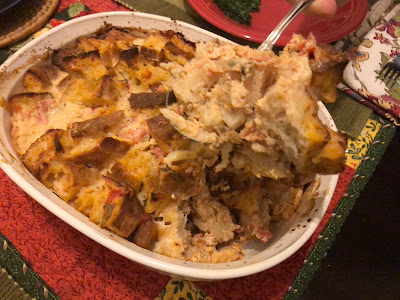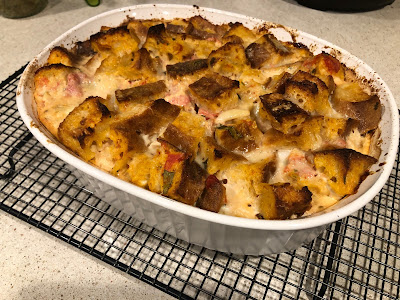Calm garlic's pungency for an easy fall casserole
Recipe: Tomatoes add color to savory bread pudding

The skins slip right off after garlic cloves are boiled in broth, which mellows the garlic's bite. (Photos: Kathy Morrison)
|
A gardener's dilemma is often solved in the kitchen.
The most recent problem I encountered was what to do with the many small cloves left over from planting my garlic. Gardeners are advised to plant only the biggest cloves, and to keep the skin on them to protect the cloves while they're growing.
But when I broke up the heads from my seed garlic (late California variety), there were so many small cloves! I did have enough big ones to plant, but I was going to have to cook the little ones soon or risk them drying out. (For the record, you also can plant the small cloves to grow garlic scapes.)
I decided to unearth a cooking trick I learned years ago: Boiling the garlic cloves in broth or water. The boiling mellows the garlic's pungency. The boiled garlic is solid, not buttery, as when whole heads are roasted.
Some home-canned yellow tomatoes, some red ones from the freezer and half a loaf of stale ciabatta bread became the rest of the base for a garlic-infused bread pudding that is a terrific casserole or side dish for a fall dinner.

|
Tomato-garlic bread pudding
Serves 6
Ingredients:
1 to 2 cups chicken or vegetable broth
20 or so smallish garlic cloves, separated from the head
6 eggs, room temperature
1 cup milk or half and half
4 cups (2 pints) peeled tomatoes, with juice if canned, cut into chunks if they're whole
Salt and pepper
Seasonings: 1 tablespoon no-salt Italian seasoning, 1 tablespoon chopped parsley (or 1 teaspoon dried),
and handful of fresh basil leaves (sliced or chopped), or any variation of this as desired
8 cups of cubes from stale bread
Grated Parmesan cheese, for sprinkling
Instructions:
Heat oven to 375 degrees F. Grease a 2-1/2 quart baking dish with oil spray or butter.
Pour the broth into a small saucepan and bring to a boil. Trim the small stem end from the garlic cloves, then add the cloves to the boiling broth. Simmer on medium heat for 10 minutes or until the tip of a knife easily goes into one of the larger cloves. Don't dump the broth when straining: Lift the cloves out with a slotted spoon and put them on a cutting board.
Slip the skins off the cloves (they may be off already) and set aside for now. (The larger cloves can be cut in half if desired.)
In a large bowl, whisk together the eggs and milk. Add the tomatoes, salt and pepper to taste, the seasonings, and the garlic cloves. Add the bread cubes and stir thoroughly. At this point you can let the cubes soak up the liquid for a bit, if the bread is very stale, or continue to baking.
If the mixture still seems a bit dry to you, add some of the broth reserved from boiling the garlic.

|
When ready to bake, pour the bread mixture into the prepared pan.
Bake uncovered for 20 minutes. Sprinkle the Parmesan over the top, and cover the dish with the lid or a large piece of foil that has been sprayed with oil on one side (to keep the cheese from sticking to the foil).
Bake covered for an additional 20 minutes. Check for doneness — the liquid should be mostly absorbed and the pudding will be puffy. Add more cheese if desired. Bake for 5 to 10 minutes more uncovered. The pudding will be bubbling on the edges and the top will be golden and crispy. A knife inserted in center should come out clean.
Serve pudding warm or room temperature. Leftovers reheat well.

